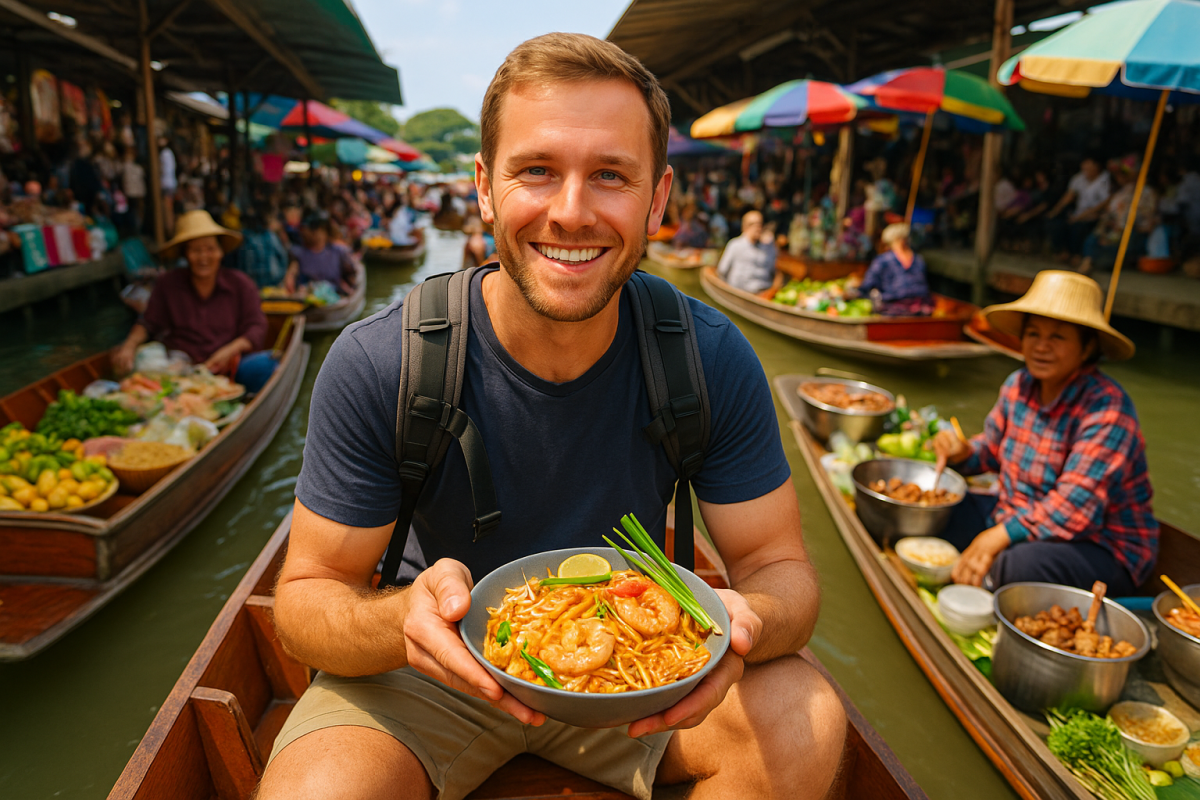- Why So Many Floating Markets? A Tale as Old as Time (and Boats)
- Khlong Lat Mayon: My Weekend Floating Market Adventure – A Sensory Overload
- Pad Thai: A Government-Approved Culinary Masterpiece – More Than Just Noodles
- A Deeper Dive into the Pad Thai Experience – A Sensory Celebration
- Boat Noodles: A Culinary Journey Through Time – More Than Just Soup
Hey folks, your friendly neighborhood American backpacker here, fresh off another incredible adventure. This time, I dove headfirst (pun intended!) into the vibrant chaos of Bangkok's floating markets. Let me tell you, it was an experience for the ages, a delicious whirlwind of sights, sounds, and enough street food to make your taste buds sing the Thai national anthem. I’d planned this trip for months, poring over travel blogs, watching YouTube videos, and even taking a rudimentary Thai phrasebook class (my pronunciation still needs work, let’s be honest). My goal? To experience the authentic heart of Thailand, and what better way to do that than by immersing myself in the unique culture and culinary delights of its legendary floating markets?
Why So Many Floating Markets? A Tale as Old as Time (and Boats)
Now, you might be wondering, why the heck are there so many floating markets in Thailand? Well, grab your metaphorical paddle, because we’re taking a quick history lesson. Before the extensive road networks and reliable land transportation that we take for granted today, waterways were the undisputed lifeblood of Thailand. Picture this: centuries ago, the intricate network of rivers and canals crisscrossed the landscape, serving as the primary arteries for commerce and communication. People navigated these watery highways in their boats, and naturally, markets followed suit. These weren't just any markets; they were vibrant, bustling marketplaces that floated gracefully on the water, a testament to the ingenuity and adaptability of the Thai people. Hence, the birth of the iconic floating markets! Many of these markets today have evolved into major tourist attractions, drawing visitors from around the globe. However, many still serve their original purpose, providing vital goods and services to the local communities that have relied on them for generations. It’s a fascinating blend of ancient tradition and modern tourism.
Khlong Lat Mayon: My Weekend Floating Market Adventure – A Sensory Overload
I chose Khlong Lat Mayon, a weekend market conveniently located not too far from the bustling heart of Bangkok. I figured this would be a great starting point, offering a good balance of accessibility and authenticity. The place was absolutely buzzing, a vibrant tapestry woven with locals and tourists alike. It was a sensory overload in the best possible way. The air hummed with a symphony of sounds: the gentle lapping of water against the boats, the cheerful chatter of vendors, the clinking of utensils, and the rhythmic thrum of Thai pop music emanating from unseen speakers. The smells were equally captivating, a tantalizing mix of fragrant spices, sweet treats, and the earthy aroma of freshly cut fruits and vegetables. The colors were simply stunning: a kaleidoscope of bright fabrics, exotic flowers, and the rich hues of the myriad culinary offerings. I hopped onto a tiny, hand-cranked boat, expertly piloted by a grizzled old-timer who looked like he’d been navigating these waterways since the reign of King Rama V. He exuded a quiet confidence and a lifetime of experience. The boat, though small, was surprisingly stable, a testament to both the captain's skill and the sturdy craftsmanship of the vessel. This was it – my adventure had truly begun.
Pad Thai: A Government-Approved Culinary Masterpiece – More Than Just Noodles
My first culinary conquest? Pad Thai, of course! This iconic Thai dish is far more than just a simple meal; it's a fascinating case study in culinary history and government intervention. This isn’t your average street food; it boasts a surprisingly compelling backstory. Introduced in the 1940s as a government-sponsored initiative to boost domestic rice consumption and stimulate the economy, it's since evolved into a beloved national treasure. This wasn't simply about boosting sales; it was a calculated move to foster national unity and pride through a shared culinary experience. The recipe, subtly inspired by the stir-fried rice noodles of China's Chaoshan region, has undergone a fascinating evolution, adapting and incorporating distinctly Thai flavors and techniques. The government's aim was to encourage the widespread adoption of Thai rice and to boost the incomes of small vendors and entrepreneurs across the country. The result? A culinary masterpiece that continues to captivate taste buds worldwide. I ordered mine with two eggs – a personal preference – and let me tell you, it was heavenly. The perfectly stir-fried rice noodles, the juicy shrimp (I opted for the shrimp, but you can find many variations!), the crunchy peanuts, the tangy lime – every element played its part in a harmonious symphony of flavors.
A Deeper Dive into the Pad Thai Experience – A Sensory Celebration
The Pad Thai wasn't just a meal; it was a sensory celebration. The vendor, a charming woman with a perpetual smile, effortlessly balanced her boat while deftly preparing the dish. The skill involved was remarkable – a seamless blend of culinary expertise and aquatic dexterity. The ingredients themselves were simple yet incredibly vibrant: white rice noodles, bean sprouts (adding a delicate crunch), chives (offering a subtle oniony note), crisp lettuce, crushed peanuts (providing a delightful textural contrast), lime wedges (delivering a zesty tang), and even a mysterious banana blossom for garnish. I was initially skeptical, but it added a surprisingly pleasant astringency that balanced the richness of the other ingredients. The sauce, a complex blend of sweet, sour, salty, and spicy, was the real star of the show, expertly balancing each element to create a flavor profile that is both comforting and exciting. The noodles themselves were wonderfully chewy, almost gummy, in the best possible way – a testament to the careful cooking process. It was a truly memorable culinary experience.
Boat Noodles: A Culinary Journey Through Time – More Than Just Soup
Next up: boat noodles! This isn’t just any noodle soup; it's a culinary journey through time, directly linked to the history of the floating markets. This hearty and flavorful soup, typically served in small, rooster-shaped bowls (a charming nod to the origins of these noodle vendors), possesses a rich history inextricably woven with the lifeblood of the floating markets. Imagine the scene: centuries ago, vendors would navigate the waterways in their boats, bringing this nourishing soup to the hardworking people who lived and worked on the river. These intrepid entrepreneurs would bring their boats alongside larger vessels, offering a quick, easy, and undeniably delicious meal to busy travelers and river workers. The ingenuity and resourcefulness are truly inspiring. Today, you'll find countless boat noodle shops throughout Bangkok, a testament to the enduring popularity of this culinary tradition. However, the original concept remains: a delicious, easily portable, and undeniably satisfying meal perfect for those on the go. I opted for egg noodles in a chicken broth, a classic choice. The broth itself was rich and flavorful, loaded with bean sprouts, water spinach (adding a touch of earthiness), pork liver (a surprisingly delicious addition), tender chicken, minced meat, fish balls, and a generous helping of coriander (a touch of freshness). The broth was incredibly thick and flavorful, a perfect combination of savory and aromatic notes.








